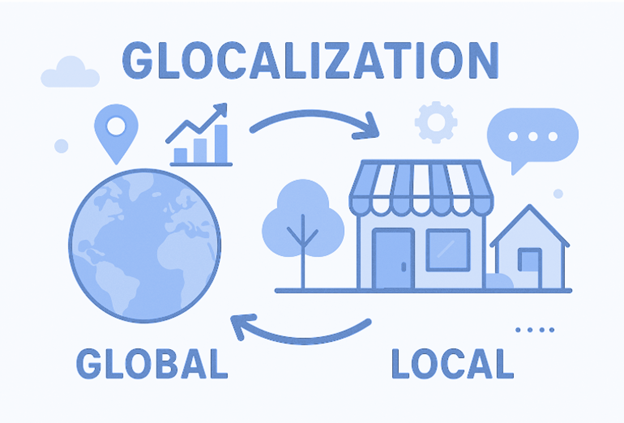Glocalization Strategy for Global Business Success
We hear a lot about localization and globalization in business but glocalization helps fill the gap.
It’s the smarter, more human way to go global.
Interested in glocalization for your strategy? Let’s dive right in!

What is Glocalization?
In the modern world, region or location does not inhibit business expansion. Although globalization offers a larger reach, at times it also does not deliver the local touch that is essential to interact with various markets in-depth. That is where the concept of glocalization emerges. Through the combination of global aspirations and indigenous knowledge, glocalization offers businesses the opportunity to connect with individuals in the world in a significant way.
Definition of Glocalization
Glocalization is derived from the words globalization and localization. The glocalization definition refers to the process of developing and distributing a product or service targeted for a global market but adapted to meet the preferences, standards, and circumstances of a particular local culture.
Origin and Glocalization Meaning
It comes from the Japanese word dochakuka which means adapting farming practices to suit the local environment. The word was picked up in the 80s and 90s by business theorists in relation to using a global product or service but adapting it to be more culture friendly.
It entails creating a product or service for a global audience, but designed and adapted for a specific local user or consumer. Glocalization marks the transition from a single solution model to a more layered focused consumer model.
Glocal vs. Global and Local Strategies
With international companies comes the consideration of whether regions are standardized or localized. Glocal strategies strike an effective compromise between global and local strategies since they offer relevance while providing consistency. Businesses can now uphold a universally accepted brand image while adapting some elements of marketing, products, and customer service to local market needs.
- Global strategy: Concentrates on sleek delivery and messaging of products across all markets with little to no adaptation of the local landscape. This strategy focuses on brand efficiency and recognition at the expense of regional preferences.
- Local strategy: Draws focus fully towards the offering for a given value. Local Strategy resonates deeply with local customers because of customization, but also increases complexity and operational costs.
- Glocal strategy: Aligns key regions of globalization such as brand identity with relevant elements including language, packaging, promotions, and user interface. It offers relevance to locals while retaining global standards. Glocal Strategy also helps businesses scale easily.
Why Glocalization Matters in Business
Reaching Global Audiences with Local Impact
Glocalization allows companies to tap into global markets while not alienating local consumers in global markets. By literally and figuratively addressing the language of those people in global (local) markets, a company will create a bookend relationship with consumers leading to brand allegiance, when the time comes for the buying decision.
In other words, many decisions involve buying cultural subtleties. A glocalization strategy can ensure that product offerings (whatever the offerings may be product, service, campaign, etc.) are culturally sound when, and if they are launched on the market. So, how do companies pull this off? Here are some key strategies they use to make a real local impact:
- Localized marketing content. This focuses on changing and adjusting a brand’s message to connect with the local culture. It goes beyond just words; it’s about the underlying meaning.
- Product modification. Modifying features, packaging, or services to fit with local customs or regulatory requirements.
- Local partnerships. Working with regional influencers or suppliers can help businesses gain trust and link up with their audience more.
- Geo-targeted digital strategies. Utilizing local SEO, native ads and social media platforms specific to each market.
Benefits of a Glocal Approach
To understand the benefits, it’s important to first define glocalization. Going glocal can be a very effective approach for firms that want to go global but also have a local touch. Firms can enable more value along various dimensions by integrating global sameness and local relevance:
- Increased Customer Engagement: Meeting local preferences increases the likelihood of purchase engagement and therefore strengthens the customer relationship.
- Enhanced Brand Reputation: To demonstrate cultural awareness is much more than just politeness – it’s a direct statement. It not only speaks positively to the communities of your brand but also it informs that your brand embraces their ethnicity. This makes people feel good about your brand and thus it becomes a reflection of being one who is not selfish and is really trying to consider others’ needs around the globe.
- Faster Market Entry and Growth: Products and services that are made considering the local standards are not just expected but also are more probable to be received and adopted hastily. Satisfied consumers spread the word, and consequently, refurnish their needs at the same time. The quick acceleration is possible when consumers are familiar with the brand and show loyalty.
- A Real Competitive Edge: Cultural customization in a world that has become oversaturated with choices can give a brand significant distinction. When the message and the proposals of the product are in sync with the target market’s values and behavior, they stand high chances of being recognized and pinpointing exactly what consumers want.
- Long-Term Profitability Through Loyalty: Brands that are connected culturally don’t only make sales—they create relatedness. In the situation that loyal customers become emotionally attached to the brand, they will stay with the brand longer, come back, and even talk their friends into buying. In that situation, a company’s trust in the market becomes constant growth and profitability.
Key Components of a Successful Glocalization Strategy
The process of glocalization involves more than translating content – it means a brand changes its products, messages along with experiences to fit local cultures and values. The brand does this as it keeps its global identity.
Language and Translation
Glocalization refers to the practice of adapting global content to fit local languages, culture along with certain expectations. In its widest sense, it includes all aspects of words. This covers articulation, phrases as well as contexts. The heart of every successful glocalization strategy is outstanding communication, thus requiring precise and culturally pertinent translation for:
- Product descriptions
- Marketing materials
- Customer support
- Legal documentation
Human translators are essential for capturing details and context, even though automated translation systems help scale initiatives.
AI combined with human attention to details allows ConveyThis to deliver accuracy at scale which is perfectly balanced. Brands would be able to preserve company voice, coherence of tone across the brand, consistency across wordings, and maintain brand persona in multiple languages, with their translation management system.
Cultural Sensitivity
In order to avoid cultural gaffes and/or a lack of cultural sensitivity it is advisable to research and understand the indigenous lifestyle, which will include aspects of cultural customs, cultural holidays, cultural tradition, and cultural taboos. Cultural sensitivity in product design can only help:
- Prevent brand damage
- Improve customer trust
- Enhance campaign effectiveness
For achieving this goal, businesses need to conduct local market research, hire consultants from those cultures, and collect opinions from the audience to adapt their approaches.
Local Regulations and Preferences
Following the local laws and regulations is a must and includes:
- Safety regulations regarding a product
- Advertising restrictions
- Data protection and privacy laws
- Labeling and packaging requirements
Also imperative is knowledge of local consumer habits, for example, the buying habits of delivery and payment, as they greatly impact the chances of purchase.
Real-World Glocalization Examples
Brands Doing It Right
Glocalization is more than just a theory— it’s a strategy used by many successful multinationals. Here are some brands that exemplify finding the perfect balance between global reach and local relevance:
- Netflix: Netflix is known for maintaining a consistent platform across the globe available to everyone. Despite these upcoming considerations, they spend large amounts of money to create localized assets, so that they can engage with the global community whilst resonating with local audiences. Korean dramas; ‘Squid Games’ and Spanish hits ‘Money Heist’ are perfect examples of this radicalization.
- KFC: Regardless of being synonymous with fried-chicken globally, KFC also modifies its menu to better suit local tastes. In China they serve congee, and in Thailand they serve green curry chicken rice, while the Chinese do consume beijing duck wraps.
- Nike: Nike has launched hyper-local campaigns that align with cultural identities and values. For example, Middle Eastern marketing sustains the regional love for modest active wear featuring local athletes while Latin America highlights football and community pride.
The above companies showcase that while the core identity can be preserved, the local market nuances invite strategic meets, delivering thoughtful adaptations aimed at fostering deeper connections
Lessons Learned
These examples illustrate that:
- Flexibility and adaptability are important.
- Local teams or partnerships enhance cultural alignment.
- Consistent brand values can be maintained alongside local adaptations.
Glocalization in Digital Marketing and E-commerce
Website Localization
Localizing a website means not only the words have to be translated, but images, design, and functionality must be adapted as well. This includes:
- Currency and payment options
- Local contact details
- Region-specific promotions
Using a multilingual website will improve your visibility in searches and engagement with users across geographies.
With ConveyThis, businesses can quickly deliver fully localized versions of their websites without having to rebuild the infrastructure of the original. The program uses automatic, unique detection of languages at the user level and includes customizable language switchers and unique SEO translations that increase visibility in local search engines.
Product Adaptation
In foreign markets product adaptation is more than mere translation—often it involves meticulous changes to respond to the cultural, regulatory, and functional needs of foreign market consumers. Some of the most critical areas of adaptation include product features, size, packaging, and brand name. For example:
- Electronic devices may require different voltage standards.
- Cosmetics must align with local beauty norms and regulations.
- Food products often need recipe changes to suit local palates.
Multilingual SEO and Local UX
Optimizing local search engines is critical to website visibility. Typical practices include:
- Keyword research in the target language
- Local backlink building
- Use of local domain extensions (ccTLDs)
By focusing on the local habits and desires of the users such as mobile-first design or the habit of navigation are examples of what brings more visits into conversions.
Challenges and Considerations
Balance Between Consistency and Customization
Global-To-Local Strategy: The way in which a global brand is able to exist and effectively operate alongside a brand that has a global foundation while at the same time coexisting with the local ones has been rated as one of the most challenging situations. On the one hand, brand identity can be diminished if it is over-labeled, and, on the other hand, brand identity can be alienated if it is over-standardized. The characteristic of a good brand policy is that it allows for the flexible application of the brand in ways that the firm might not have intended or even have been as clear as a normal brand policy. This will have the effect of making the brand stronger, bigger or stronger and bigger at the same time as professionally showing it to the outside world.
Resource and Workflow Implications
The technical dynamics of glocalization need time, monetary resources, and coordination. It is necessary to run some of the necessary problems:
- Coordinating with multiple stakeholders across regions
- Managing version control of translated content
- Expansion and perpetuation of the quality
ConveyThis aims at solving most of these challenges through its one-stop centralized platform, thanks to which your company can efficiently handle language assets, translations, workflows, and updates, to say nothing of duplication reduction and ensuring quality is maintained even with increased volume.
How to Implement a Glocalization Strategy
Tools and Technologies
The process of glocalization is greatly enhanced by technology. Key tools include:
- Translation management systems (TMS): For managing multilingual content efficiently
- Content management systems (CMS): That support multilingual site versions
- AI-powered translation tools: For rapid, scalable translation with post-editing
- Analytics platforms: To track local performance metrics
Workflow Best Practices
A successful glocal strategy involves:
- Market research: Understand the needs, behaviors and expectations of every target market.
- Prioritization: Determine a list of markets, and then prioritize changing the core message into an opportunity for localization in the markets that show the most potential or is the greatest need.
- Pilot programs: In most cases, companies should conduct tailored local pilot programs before rolling out the local strategy to include every part of the business.
- Feedback loops: Companies must take user feedback from all local users of a product or service before making adaptation to the local and global model. This will drive better decision-making to the brand.
- Documentation: Record updates, produce style guides, glossaries and localization playbooks.
Partnering with Translation Providers
External language service providers bring expertise in both translation and localization. When selecting a provider, consider:
- Experience in your industry
- Use of certified linguists
- Quality assurance processes
- Cultural consultancy services
Through its localization solutions, ConveyThis gets the website translated, improved search position in multiple languages, and even adapts it to local needs all in one go, thus giving a clear signal to firms that are stepping to glocalization as a trusted partner, in order to enable the application of such a strategy.
In Conclusion
Glocalization is not only simply an experiential marketing trend, it inevitably becomes a requirement for almost any business attempting to grow and act strategically in a global marketplace and still simultaneously thinking about doing the same on a local level.
Implementing a thoughtful glocalization takes some effort in terms of planning, culture comprehension, and functional alignment, but the important benefits are evident; customer loyalty, greater perceived brand trust, and a positioning advantage against competitors. In a cultural latitude in which a consumer looks for personalization and expects respect for their culture and values, glocalization should no longer be considered optional for long-term global success.
To explore how your business can implement glocalization through seamless website translation and localization, visit ConveyThis.
Article written by Kavita R.
Translation, far more than just knowing languages, is a complex process.
By following our tips and using ConveyThis , your translated pages will resonate with your audience, feeling native to the target language.
While it demands effort, the result is rewarding. If you’re translating a website, ConveyThis can save you hours with automated machine translation.
Try ConveyThis free for 3 days!
 No card details
No card details



